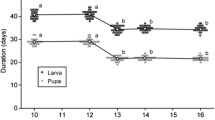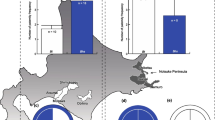Abstract
Superparasitism is a widespread phenomenon in parasitoids and may be advantageous in some circumstances. In this study, offspring sex ratio was analysed in three superparasitism situations: when the second egg was laid by a random Eupelmus vuilleti (Hymenoptera: Eupelmidae) female from a group, when an isolated female was allowed to lay two eggs on the same host (self-superparasitism) or laid one egg on a host already parasitized by a conspecific (conspecific superparasitism). Females produced a different offspring sex ratio according to the different superparasitism situations tested. These sex ratios are in line with the local mate competition theory. The results further suggest that females can discriminate between hosts parasitized by a conspecific or by themselves and adapt the sex of the eggs they lay accordingly.


Similar content being viewed by others
References
Aron S, De Menten L, van Bockstaele D (2003) Brood sex ratio determination by flow cytometry in ants. Mol Ecol Notes 3:471–475
Bai B, Mackauer M (1990) Oviposition and host feeding in Aphelinus asychis (Hymenoptera: Aphelinidae) at different aphid densities. Ecol Entomol 15:9–16
Charnov EL (1982) The theory of sex allocation. Princeton Univ. Press, Princeton, NJ
Charnov EL, Stephens DW (1988) On the evolution of host selection in solitary parasitoids. Am Nat 132:707–722
Darrouzet E, Huignard J, Chevrier C (2002) Effect of differential host exposure on reproduction in the solitary ectoparasitoid Eupelmus vuilleti. Entomol Exp Appl 103(1):73–81
Darrouzet E, Imbert E, Chevrier C (2003) Self-superparasitism consequences for offspring sex ratio in the solitary ectoparasitoid Eupelmus vuilleti. Entomol Exp Appl 109:167–171
Darrouzet E, Bignon L, Chevrier C (2007) Impact of mating status on egg-laying and superparasitism behaviour in a parasitoid wasp. Entomol Exp Appl 123:279–285
Galloway KS, Grant B (1989) Reverse sex ratio adjustment in an apparently outbreeding wasp, Bracon hebetor. Evolution 43:465–468
Gauthier N, Monge JP, Huignard J (1996) Superparasitism and host discrimination in the solitary ectoparasitoid Dinarmus basalis. Entomol Exp Appl 79(1):91–99
Godfray HCJ (1994) Parasitoids, behavioral and evolutionary ecology. Princeton Univ. Press, Princeton, NJ
Hamilton WD (1967) Extraordinary sex ratios. Science 156:477–488
Hardy ICW (2002) Sex ratios concepts and research methods. Cambridge Univ. Press, Cambridge
Islam KS, Copland MJW (2000) Influence of egg load and oviposition time interval on the host discrimination and offspring survival of Anagyrus pseudococci (Hymenoptera: Encyrtidae), a solitary endoparasitoid of citrus mealybug, Planococcus citri (Hemiptera: Pseudococcidae). Bull Entomol Res 90(1):69–75
King BH (1987) Offspring sex ratios in parasitoid wasps. Quarterly Rev Biol 62(4):367–396
King BH (1993) Sex ratio manipulation by parasitoid wasps. In: Wrensch and Ebbert (ed) Evolution and diversity of sex ratio in insects and mites. New York, p 419–441
King BH, Skinner SW (1991) Proximal mechanisms of the sex ratio and clutch size responses of the wasp Nasonia vitripennis to parasitized hosts. Anim Behav 42:23–32
Mayhew PJ, Hardy ICW (1998) Nonsiblicidal behavior and the evolution of clutch size in bethylid wasps. Am Nat 151:409–424
Mayhew PJ, van Alphen JJM (1999) Gregarious development in alysiine parasitoids evolved through a reduction in larval aggression. Anim Behav 58:131–141
Rosenheim JA, Hongkham D (1996) Clutch size in an obligately siblicidal parasitoid wasp. Anim Behav 51(4):841–852
Shiga M, Nakanishi A (1968) Variation in the sex ratio of Gregopimpla himalayensis Cameron (Hymenoptera: Ichneumonidae) parasitic on Malacosoma neustria testacea Molschulsky (Lepidoptera: Lasiocampidae) with considerations on the mechanism. Kontyû 36:369–376
Shuker DM, West SA (2004) Information constraints and the precision of adaptation: Sex ratio manipulation in wasps. Proc Natl Acad Sci U S A 101(28):10363–10367
Shuker DM, Pen I, Duncan AB, Reece SE, West SA (2005) Sex ratios under asymmetrical local mate competition: theory and a test with parasitoid wasps. Am Natur 166(3):301–316
Shuker DM, Pen I, West SA (2006) Sex ratios under asymmetrical local mate competition in the parasitoid wasp Nasonia vitripennis. Behav Ecol 17:345–352
Suzuki Y, Tsuji H, Sasakawa M (1984) Sex allocation and effects of superparasitism on secondary sex ratios in the gregarious parasitoid, Trichogramma chilonis (Hymenoptera: Trichogrammatidae). Anim Behav 32:478–484
Ueno T (1994) Self-recognition by the parasitic wasp Itoplectis naranyae (Hymenoptera: Ichneumonidae). Oikos 70:333–339
Ueno T, Tanaka T (1997) Comparison between primary and secondary sex ratios in parasitoid wasps using a method for observing chromosomes. Entomol Exp Appl 82:105–108
van Alphen JJM, Nell HW (1982) Superparasitism and host discrimination by Asobara tabida Nees (Braconidae: Alysiinae), a larval parasitoid of drosophilidae. Neth J Zool 32(2):232–260
van Alphen JJ, Visser ME (1990) Superparasitism as an adaptive strategy for insect parasitoids. Annu Rev Entomol 35:59–79
van Baaren J, Nénon JP (1996) Intraspecific larval competition in two solitary parasitoids, Apoanagyrus (Epidinocarsis) lopezi and Leptomastix dactylopii. Entomol Exp App 81:325–333
van Dijken MJ, Waage JK (1987) Self- and conspecific superparasitism by the egg parasitoid Trichogramma evanescens. Entomol Exp Appl 43:183–192
van Lenteren JC (1981) Host discrimination by parasitoids. In: Nordlund DA, Jones RL, Lewis WJ (eds) Semiochemicals: their role in pest control. Wiley, pp 153–179
Visser ME (1993) Adaptive self- and conspecific superparasitism in the solitary parasitoid Leptopilina heterotoma (Hymenoptera: Eucoilidae). Behav Ecol 4(1):22–28
Visser ME, van Alphen JJM, Nell HW (1990) Adaptive superparasitism and patch time allocation in solitary parasitoids: the influence of the number of parasitoids depleting a patch. Behaviour 114(1–4):21–35
Völkl W, Mackauer M (1990) Age-specific pattern of host discrimination by the aphid parasitoid Ephedrus californicus Baker (Hymenoptera: Aphidiidae). Can Entomol 122:349–361
Waage JK (1986) Family planning in parasitoids: adaptative patterns of progeny and sex allocation. In: Waage JK, Greathead D (eds) Insect parasitoids. Academic, London, pp 63–95
Werren JH (1980) Sex ratio adaptations to local mate competition in a parasitic wasp. Science 208:1157–1159
Wilson K, Hardy ICW (2002) Statistical analysis of sex ratios: an introduction. In: Hardy ICW (ed) Sex ratios: concepts and research methods. Cambridge Univ. Press, Cambridge, pp 48–92
Acknowledgements
We would like to thank M.L. Vidal, A. Fertin, J. Casas, and anonymous reviewers for providing useful comments on the manuscript, E. Yates (a native English-speaker) for correcting the English and E. Imbert for rearing the insects.
Author information
Authors and Affiliations
Corresponding author
Rights and permissions
About this article
Cite this article
Darrouzet, E., Boivin, G. & Chevrier, C. Sex Allocation Decision Under Superparasitism by the Parasitoid Wasp Eupelmus vuilleti . J Insect Behav 21, 181–191 (2008). https://doi.org/10.1007/s10905-008-9118-3
Revised:
Accepted:
Published:
Issue Date:
DOI: https://doi.org/10.1007/s10905-008-9118-3




